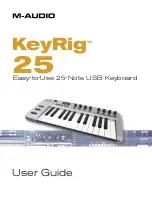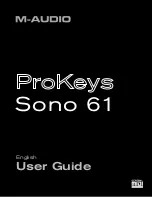
— 2 —
Other Functions
Transpose:
49 steps (–24 semitones to +24 semitones)
Tuning:
Variable (A4 = approximately 440Hz
±
100 cents)
LCD:
Adjustable contrast
SMF Player
Flash memory storage for up to 200 files*
• Supported Format: SMF0
Flash Memory
Capacity: 2MB
Shared Area: Approximately 1.5MB (waveform data, accompaniment data,
SMF data)
• Further storage of waveform, accompaniment, and SMF data becomes
impossible after the total of such data reaches approximately 1.5MB.
Terminals
MIDI Terminals:
IN, OUT
Sustain/Assignable Terminal: Standard jack (sustain, sostenuto, soft, rhythm start/stop)
Headphone/Output Terminal: Stereo standard jack
Output Impedance: 140
Ω
Output Voltage: 4.5V (RMS) MAX
Power Supply Terminal:
9V DC
Power Supply:
Dual power supply system
Batteries:
6 D-size batteries
Battery Life:
Approximately 4 hours continuous operation on manganese batteries
AC Adaptor:
AD-5
Auto Power Off:
Turns power off approximately six minutes after last key operation. Enabled
under battery power only, can be disabled manually.
Speaker Output:
3W + 3W
Power consumption:
9V
7.7W
Dimensions:
96.0
×
37.5
×
14.6 cm (37
13
/
16
×
14
3
/
4
×
5
3
/
4
inch)
Weight:
Approximately 5.6 kg (12.3lbs) (without batteries)
* The same memory area is used to store waveform data, accompaniment data, and SMF data.
ELECTRICAL
Current drain with 9 V DC:
No sound output
1200 mA
±
20 %
Maximum volume
260 mA
±
20 %
with 16 keys from C1 to D#2 pressed in 193 BREATHY ALTO SAX (R channel)
Volume: maximum, Velocity: maximum
Speaker output level (Vrms with 4
Ω
load each channel):
with key G1 in 193 BREATHY ALTO SAX (R channel)
Volume: maximun, Velocity: maximum
L/R: 3700 mV
±
20 %
Phone output level (Vrms with 32
Ω
load each channel):
with key, E1 in 193 BREATHY ALTO SAX (R channel)
Volume: maximun, Velocity: maximum
L/R: 320 mV
±
20 %
Output level (Vrms with 47
Ω
load each channel):
with key E1 in 193 BREATHY ALTO SAX (R channel)
Volume: maximun, Velocity: maximum
L/R: 1750 mV
±
20 %
About General MIDI
General MIDI standardizes MIDI data for all sound source types, regardless of manufacturer. General MIDI
specifies such factors as tone numbering, drum sounds, and available MIDI channels for all sound sources.
This standard makes it possible for all MIDI equipment to reproduce the same nuances when playing
General MIDI data, regardless of the manufacturer of the sound source.
This keyboard supports General MIDI, so it can be used to play commercially available pre-recorded
General MIDI data and General MIDI data send to it from a personal computer.
Summary of Contents for CTK-691
Page 1: ...ELECTRONIC KEYBOARD CTK 691 CTK 691 JUN 2003 Ver 2 Sep 2006...
Page 7: ...5 PRINTED CIRCUIT BOARDS Main PCB M705 MA1M Top View Bottom View...
Page 8: ...6 Sub PCB M705 MA2M LCD PCB M705 LCD1M Top View Top View...
Page 19: ...17 SCHEMATIC DIAGRAMS Main PCB M705 MA1M...
Page 20: ...18 Sub PCB M705 MA2M...
Page 21: ...19 CONSOLE PCBs M705 CN1M CN2M CN3M CN4M...
Page 22: ...20 Display PCB M705 LCD1M...





































